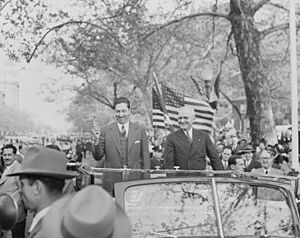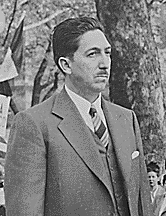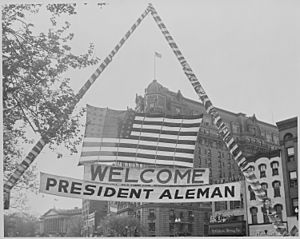Miguel Alemán Valdés facts for kids
Quick facts for kids
Miguel Alemán Valdés
|
|
|---|---|
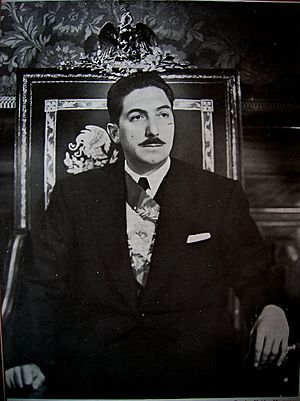
Miguel Alemán Valdés, c. 1946-52
|
|
| 53rd President of Mexico | |
| In office 1 December 1946 – 30 November 1952 |
|
| Preceded by | Manuel Ávila Camacho |
| Succeeded by | Adolfo Ruiz Cortines |
| Secretary of the Interior | |
| In office 1 December 1940 – 18 June 1945 |
|
| President | Manuel Ávila Camacho |
| Preceded by | Ignacio García Téllez |
| Succeeded by | Primo Villa Michel |
| Governor of Veracruz | |
| In office 1 December 1936 – 6 April 1939 |
|
| Preceded by | Ignacio Herrera Tejeda |
| Succeeded by | Fernando Casas Alemán |
| Personal details | |
| Born |
Miguel Alemán Valdés
29 September 1900 Sayula de Alemán, Veracruz, Mexico |
| Died | 14 May 1983 (aged 82) Mexico City, Mexico |
| Cause of death | Myocardial infarction |
| Resting place | Basilica of Our Lady of Guadalupe |
| Political party | Institutional Revolutionary Party |
| Spouse |
Beatriz Velasco
(m. 1931; died 1981) |
| Signature |  |
Miguel Alemán Valdés (Spanish pronunciation: [miˈɣel aleˈman]; 29 September 1900 – 14 May 1983) was a Mexican politician. He served as the President of Mexico from 1946 to 1952. He was the first president who was not a general from the Mexican Revolution.
During his time as president, Mexico grew quickly in industry. This period is often called the Mexican Miracle. His presidency also saw a new type of Mexican leader. Many people in his government were young, educated civilians. They were often friends from his university days.
Contents
Early Life and Education
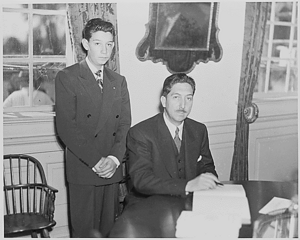
Miguel Alemán Valdés was born in Sayula, Veracruz, Mexico. His father, Miguel Alemán González, was a general in the Mexican Revolution. His mother was Tomasa Valdés Ledezma.
Young Miguel's schooling was not always steady because his family moved often. He went to schools in different towns. For a time, he worked at a British oil company. There, he learned to speak English very well.
His father told him to choose a more stable job than being a soldier. So, Miguel decided to study law. He attended the National Preparatory School in Mexico City from 1920 to 1925. He then studied law at the National University (UNAM) until 1928. He wrote his law paper on diseases and accidents that workers got on the job.
At UNAM, he led a group of friends who later became important in Mexico. Many of them served in his government when he became president.
A Career in Law
As a lawyer, Miguel Alemán first helped miners who suffered from a lung disease called silicosis. He won two important cases for workers against large companies. First, he got money for the families of railroad workers who died in revolutionary battles. Second, he helped miners who were hurt at work get paid. These wins made him popular with Mexico's labor unions.
Political Journey
First Steps in Government
Alemán began working for the government as a legal advisor in 1928. He held other positions, including serving on the Federal Board of Conciliation and Arbitration in 1930. In 1933, he became the President of the Unifying Committee for Plutarco Elías Calles, which made him more well-known.
He then served as a Senator for his home state of Veracruz from 1934 to 1936. He represented the Party of the Mexican Revolution, which later became the PRI. When the elected governor of Veracruz was killed, Alemán was appointed governor from 1936 to 1939.
From 1940 to 1945, he served as Secretary of the Interior under President Manuel Ávila Camacho. He had also managed Ávila Camacho's presidential campaign. During World War II, as Secretary of the Interior, he worked to prevent spying and dealt with groups that were seen as a threat to Mexico.
Becoming President

In 1945, President Ávila Camacho chose Alemán to be the official candidate for president in the 1946 election. This was a big deal because all previous presidents after the revolution had been military generals. Alemán was a civilian.
Alemán traveled all over the country during his campaign, just like President Lázaro Cárdenas had done before him. This allowed him to meet many voters. He won the election on July 7, 1946, defeating Ezequiel Padilla. He became the first non-military person to become president of Mexico. The change of power happened peacefully.
Presidential Term (1946-1952)
Miguel Alemán became President on December 1, 1946. He served a full six-year term until 1952. He was very popular at the start of his presidency.
As president, he strongly supported Mexico's industrial growth. This meant the government helped businesses grow and produce more goods within Mexico. This period of fast economic growth and industry development is known as the Mexican miracle.
Government Team
Alemán's cabinet (his main advisors and ministers) were mostly young, educated civilians. Many of them were his close friends from his law school days at UNAM.
What He Did for Mexico
Building Infrastructure
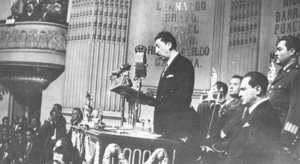
Alemán's government spent money on developing industries and public works. He invested in building dams, which helped control floods and provided water for farming and electricity. For example, a big dam project in Oaxaca was started in 1947.
He also worked on improving Mexico's transportation. He extended the rail network and built new highways. These improvements helped connect distant parts of the country to the national economy. The Mexico City International Airport was also made bigger during his term.
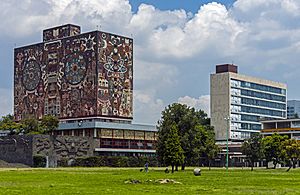
His administration also built a brand new campus for the National University (UNAM) in Mexico City.
In 1952, his government made Baja California a state. He also played a big part in making Acapulco a famous place for tourists from around the world. While the economy grew, not everyone benefited equally from this growth.
Working with Other Countries
During his time as president, Mexico kept a close relationship with the United States. This relationship had grown strong during World War II. However, he decided not to send Mexican troops to fight in the Korean War.
In 1947, he created the Mexican DFS intelligence agency. This agency worked to keep Mexico stable and safe from internal threats.
He also got a large loan from the United States in 1947. Alemán visited Washington, D.C., and rode in a parade with U.S. President Harry S. Truman. He also signed peace agreements with Japan, Germany, and Italy after World War II. He helped with a truce between Pakistan and India.
Choosing a Successor
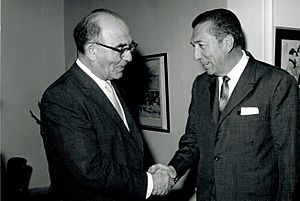
Following party tradition, Alemán chose the next presidential candidate for the PRI. He picked Adolfo Ruiz Cortines, who was known for being honest. There were rumors that Alemán wanted to stay in power longer. However, former President Lázaro Cárdenas strongly disagreed with this idea.
The 1952 election was more competitive than the one in 1946. Miguel Henríquez Guzmán, a military officer, also wanted to be the PRI candidate. He had support from some important politicians and military officers. Alemán still chose Ruiz Cortines. The PRI won the election, but other parties showed that the PRI was not completely dominant. This was the last election where the president openly chose his successor before the campaign.
Life After the Presidency
After his time as president, Miguel Alemán Valdés became very wealthy. He led Mexico's tourism agency and was a major owner of Mexican media, including the large television channel Televisa. He was also a leader of the right-wing part of the PRI.
In 1961, he became the president of the national tourist commission. He was important in helping Mexico host the 1968 Summer Olympics. He also became the first president of the Mr. Amigo Association in 1964. This group celebrates the friendship between the United States and Mexico.
His memoirs, called Remembranzas y testimonios, were published in 1987. His son, Miguel Alemán Velasco, is the CEO of Grupo Alemán, which used to include the airline Interjet.
See also
 In Spanish: Miguel Alemán Valdés para niños
In Spanish: Miguel Alemán Valdés para niños


